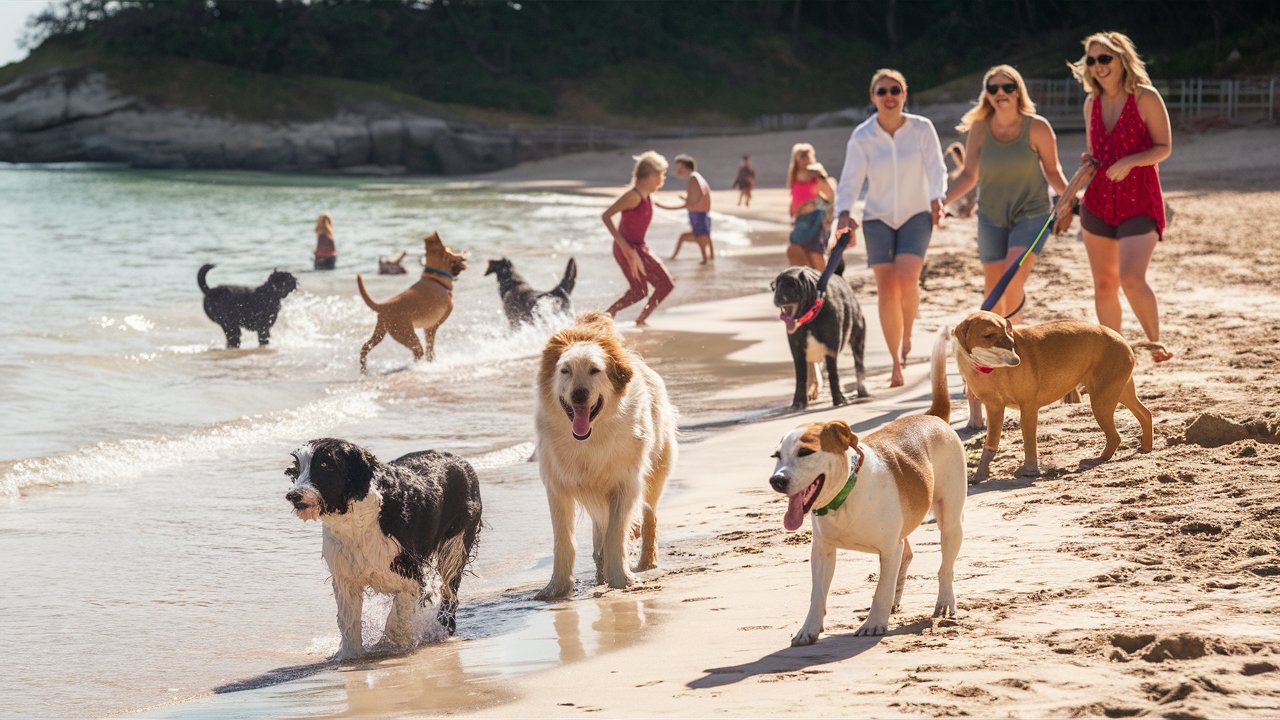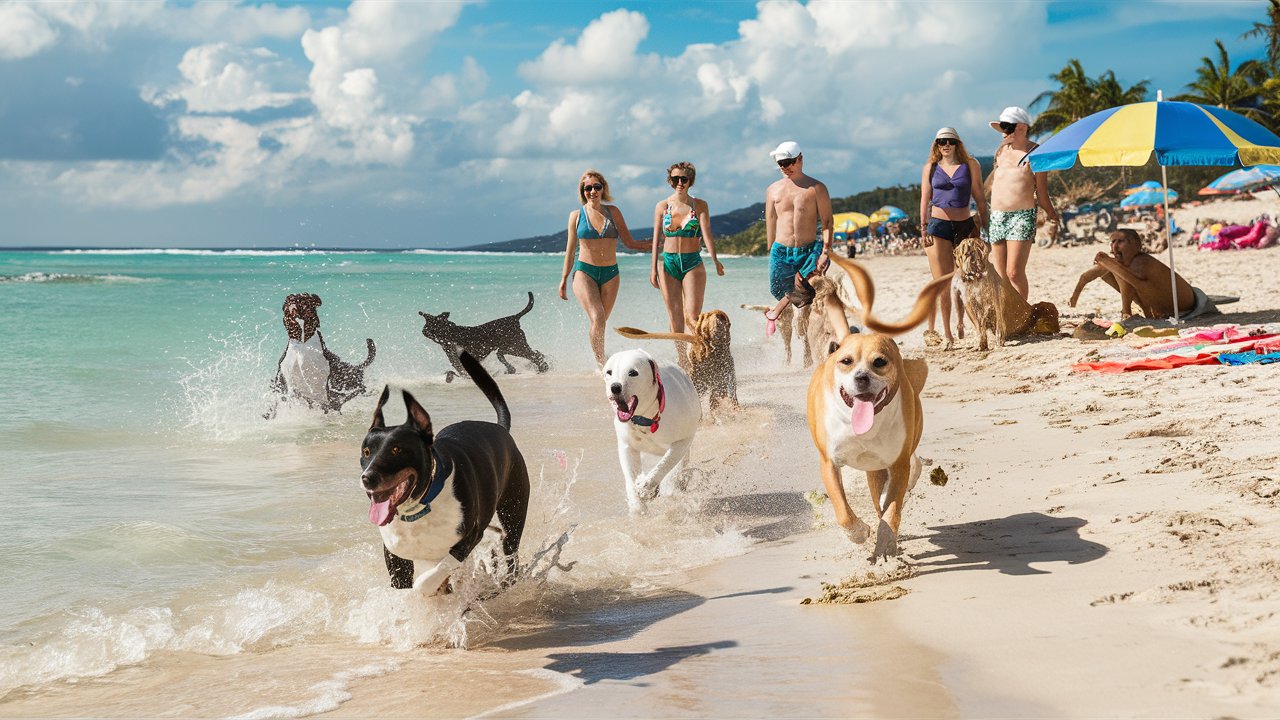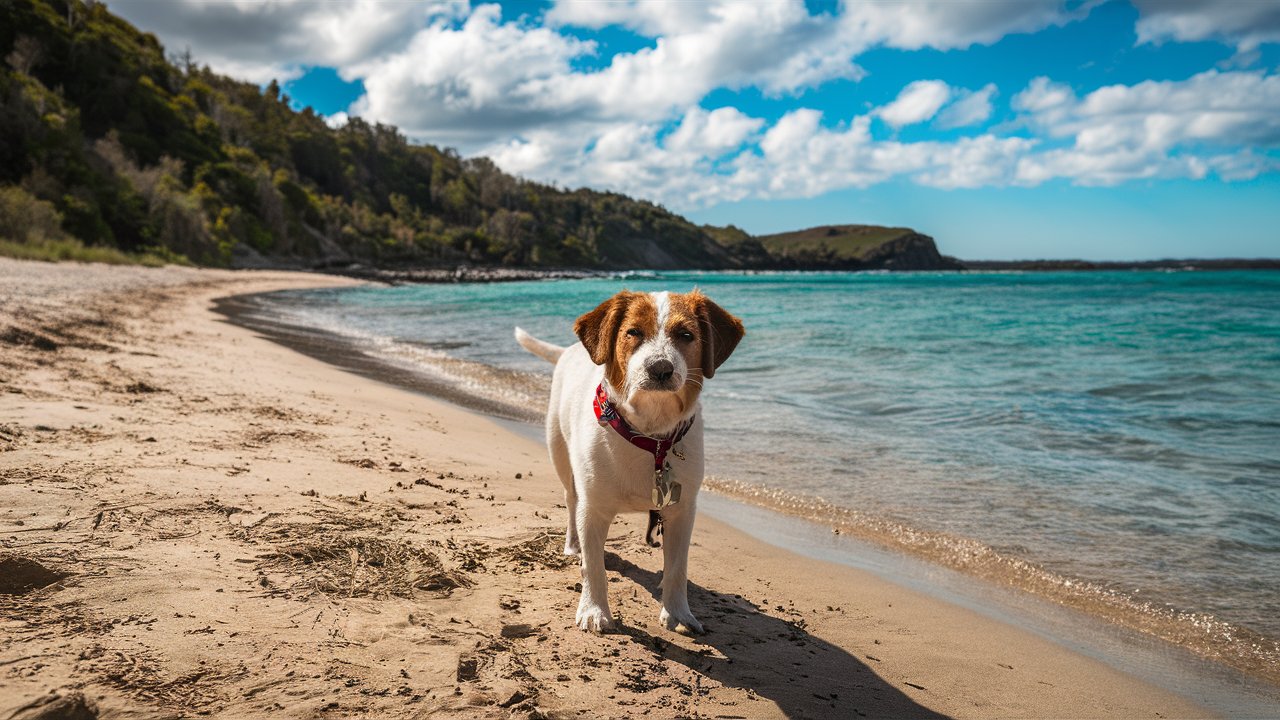Discovering Dog-Friendly Beaches: 100% Guide to Safe and Enjoyable Adventures
Imagine the joy of watching your furry friend romp freely on the soft sands of a beach, ears flapping in the breeze, and eyes gleaming with delight. For many dog owners, finding dog-friendly beaches is not just a quest for relaxation but a crucial aspect of ensuring their pets lead happy, active lives. This comprehensive guide explores the best dog-friendly beaches around the world, offering insights into safety, amenities, and the sheer joy of bonding with your canine companion amidst stunning coastal landscapes.
Dog-Friendly Beaches?

Dog-friendly beaches offer a unique environment that goes beyond the typical park setting, providing a variety of benefits that contribute to the overall well-being of dogs and enhance the experience for their owners. Here’s why many dog owners opt for these coastal havens:
1. Space for Unrestricted Movement: Dog-friendly beaches often feature expansive stretches of sand where dogs can run, play fetch, and explore freely. Unlike confined spaces, such as dog parks, beaches offer a more natural terrain that allows dogs to engage in physical activities like digging and swimming, which are essential for their health and vitality.
2. Opportunities for Socialization: Dogs are social creatures, and beaches provide an ideal setting for them to interact with other dogs and people. These interactions help dogs develop social skills, learn appropriate behavior, and build confidence in various environments. For owners, beach visits foster a sense of community among fellow dog enthusiasts, creating opportunities for sharing experiences and tips.
3. Physical and Mental Stimulation: The sensory-rich environment of a beach—featuring the sights, sounds, and smells of the sea—stimulates dogs mentally and physically. The uneven terrain, shifting sands, and ocean waves provide natural obstacles and challenges that encourage physical fitness and mental agility. Such stimulation helps prevent boredom and can alleviate behavioral issues caused by excess energy or lack of mental engagement.
4. Exposure to Nature’s Elements: Beach outings expose dogs to natural elements like sun, sand, and seawater, which can have therapeutic benefits. Sun exposure aids in the production of vitamin D, essential for bone health, while the texture of sand provides natural paw exfoliation. Swimming in the ocean offers low-impact exercise that can be beneficial for joint health and muscle tone, particularly for older dogs or those recovering from injury.
5. Bonding Time with Owners: Visiting a dog-friendly beach strengthens the bond between dogs and their owners through shared experiences and quality time spent together. Whether playing fetch, exploring tidal pools, or simply lounging under the shade of an umbrella, these moments create lasting memories and reinforce the emotional connection between pet and owner.
6. Escape from Urban Constraints: For dogs living in urban areas, dog-friendly beaches offer a refreshing escape from the hustle and bustle of city life. The tranquil surroundings, soothing sounds of the waves, and open spaces provide a welcome respite where dogs can unwind, recharge, and reconnect with their natural instincts.
7. Promotion of Responsible Pet Ownership: Responsible behavior is encouraged and reinforced at dog-friendly beaches, where owners are expected to clean up after their pets and adhere to local regulations. These beaches foster a culture of respect for the environment and consideration for other beachgoers, promoting a positive experience for all visitors, both human and canine.
8. Support for Local Communities: Dog-friendly beaches contribute to the local economy by attracting visitors who seek pet-friendly accommodations, dining options, and recreational activities. By supporting these establishments, dog owners contribute to the sustainability of coastal communities and help advocate for the expansion of pet-friendly amenities and services.
What Makes a Beach Dog-Friendly?

Choosing the right beach for you and your canine companion involves considering several key factors that contribute to a positive and fulfilling experience. A truly dog-friendly beach goes beyond simply allowing dogs; it prioritizes safety, convenience, and amenities that cater to the needs of pets and their owners alike. Here’s what to look for:
1. Leash Policies and Designated Areas: Dog-friendly beaches typically have clear leash policies that outline where dogs are permitted to be off-leash and where they must remain on-leash. Designated off-leash areas are ideal for dogs to roam freely and interact with other pets, while on-leash areas ensure safety and compliance with local regulations. Clear signage and maps of the beach layout help owners navigate these zones effectively.
2. Cleanliness and Amenities: A well-maintained dog-friendly beach provides amenities that enhance comfort and convenience for both dogs and their owners. These may include:
- Waste Disposal Stations: Strategically placed bins with waste bags encourage responsible pet ownership by making it easy for owners to clean up after their dogs.
- Fresh Water Sources: Access to clean drinking water helps keep dogs hydrated, especially on hot days when they may be more prone to dehydration.
- Shaded Areas and Seating: Sheltered spots and benches provide respite from the sun and allow owners to relax while supervising their pets.
3. Safety Measures and Regulations: Safety should be a top priority at dog-friendly beaches. Beaches that implement safety measures and adhere to local regulations create a secure environment for dogs and their owners. Key considerations include:
- Emergency Services: Proximity to veterinary clinics or emergency services ensures prompt assistance in case of accidents or health emergencies.
- Awareness of Hazards: Awareness of potential hazards such as strong currents, marine wildlife, or toxic plants allows owners to take precautions and protect their pets from harm.
- Seasonal Considerations: Awareness of seasonal changes, such as high tides or nesting periods for local wildlife, helps visitors plan their beach outings responsibly.
4. Community and Visitor Etiquette: Dog-friendly beaches thrive on a culture of mutual respect and consideration among beachgoers. Encouraging responsible behavior and fostering a sense of community helps maintain the beach’s dog-friendly status. This includes:
- Respect for Other Beachgoers: Keeping dogs under control, avoiding excessive noise, and respecting the space of other visitors contribute to a positive experience for everyone.
- Educational Outreach: Providing information and resources on responsible pet ownership and beach etiquette helps educate visitors and promote a harmonious beach environment.
5. Accessibility and Inclusivity: Accessible facilities and accommodations ensure that dog-friendly beaches are welcoming to all visitors, including those with mobility challenges or special needs. Features such as wheelchair ramps, accessible parking, and clear signage enhance the beach experience for everyone, regardless of ability.
6. Environmental Stewardship: Responsible stewardship of the beach environment benefits both wildlife and future generations of beachgoers. Practices such as minimizing waste, respecting wildlife habitats, and participating in beach cleanup efforts contribute to the preservation of natural ecosystems and ensure the sustainability of dog-friendly beach initiatives.
Dog-Friendly Beaches Around the Globe

Exploring dog-friendly beaches worldwide opens up a world of adventure and relaxation for both dogs and their owners. From sandy stretches along the coast of California to secluded coves in Australia and vibrant urban beaches in Europe, here are more exceptional destinations where dogs can roam, play, and splash to their hearts’ content:
California, USA:
- Carmel Beach, California: Nestled along the scenic Monterey Peninsula, Carmel Beach is renowned for its expansive sands and relaxed leash laws. Dogs can enjoy off-leash freedom to explore the shoreline while their owners soak in stunning views of the Pacific Ocean and the iconic Pebble Beach Golf Links.
- Huntington Dog Beach, California: Located in Orange County, Huntington Dog Beach is a paradise for water-loving pups. This beach features designated off-leash areas where dogs can frolic in the surf, chase frisbees, and even try their paws at surfing during annual events like the Surf City Surf Dog competition.
Australia:
- Mornington Peninsula, Victoria: Just an hour’s drive from Melbourne, the Mornington Peninsula boasts several dog-friendly beaches that cater to both relaxation and adventure. Rye Beach and Portsea Beach are popular choices, offering expansive sands, clear waters, and breathtaking coastal scenery that dogs and their owners can explore together.
- Gold Coast, Queensland: Known for its year-round sunshine and golden beaches, the Gold Coast offers several designated dog-friendly beaches. Tallebudgera Dog Beach and Palm Beach are favorites among locals and visitors alike, providing ample space for dogs to run, swim, and socialize against the backdrop of skyscrapers and lush hinterland.
Europe:
- Cornwall, UK: Cornwall’s rugged coastline is dotted with dog-friendly beaches that cater to both relaxation and adventure. Porthcurno Beach, with its turquoise waters and dramatic cliffs, and St. Ives Bay, with its picturesque coves and bustling harbor, offer diverse experiences for dogs and their owners seeking coastal escapades in southwestern England.
- Barcelona, Spain: Despite being a bustling metropolis, Barcelona offers several urban beaches where dogs are welcome to join their owners for sun-soaked adventures. Barceloneta Beach, with its lively atmosphere and panoramic views of the Mediterranean Sea, provides designated areas where dogs can play in the sand and splash in the shallow waters.
New Zealand:
- Auckland Region, New Zealand: Auckland’s stunning coastline features several dog-friendly beaches that cater to both urban and rural preferences. Beaches such as Long Bay Beach and Takapuna Beach offer designated off-leash areas where dogs can enjoy the sand and surf while their owners take in views of volcanic islands and serene bays.
Canada:
- Vancouver, British Columbia: Vancouver’s proximity to the Pacific Ocean provides ample opportunities for dogs to enjoy the beach alongside their owners. Locarno Beach and Spanish Banks Beach, with their expansive sands and views of the North Shore Mountains, offer designated off-leash areas where dogs can run, swim, and socialize in a picturesque coastal setting.
Caribbean:
- Puerto Rico: The island of Puerto Rico boasts several dog-friendly beaches where pets can join their owners for tropical adventures. Balneario de Carolina and Pine Grove Beach in San Juan offer designated areas where dogs can play in the sand and splash in the turquoise waters of the Caribbean Sea, providing a refreshing escape for both locals and visitors.
Tips for a Successful Visit Dog-Friendly Beaches

Visiting a dog-friendly beach offers a fantastic opportunity for dogs to play, exercise, and socialize in a natural, stimulating environment. To make the most of your beach outing and ensure a positive experience for everyone, consider these essential tips:
1. Check Local Regulations and Leash Policies: Before heading to the beach, familiarize yourself with local regulations regarding dogs. This includes leash laws, designated off-leash areas, beach hours, and any specific rules or restrictions that may apply. Adhering to these regulations not only ensures compliance but also promotes a safe and harmonious environment for all beachgoers.
2. Pack Essentials for Your Dog: Ensure you have everything your dog needs for a comfortable and enjoyable day at the beach. Essential items to pack include:
- Leash and Harness: Even if the beach allows off-leash activities in designated areas, it’s wise to have a leash and harness handy for times when additional control is necessary.
- Water and Bowl: Hydration is key, especially on hot days. Bring plenty of fresh water and a portable bowl to keep your dog hydrated throughout your visit.
- Sun Protection: Just like humans, dogs can get sunburned. Consider applying pet-safe sunscreen to exposed areas, such as the nose and ears, particularly for dogs with short or light-colored fur.
- Towel and Shade: Pack a towel for drying off your dog after swimming and to provide a comfortable spot for them to rest. If there’s limited natural shade, bring an umbrella or beach tent to provide shelter from the sun.
3. Respect Beach Etiquette: Practicing good beach etiquette ensures a positive experience for everyone sharing the beach. Some important etiquette tips include:
- Clean Up After Your Dog: Always pick up after your dog and dispose of waste in designated bins. Carry waste bags with you and be proactive in keeping the beach clean.
- Control Your Dog’s Behavior: Keep your dog under control at all times, whether on or off-leash. Avoid allowing your dog to approach unfamiliar dogs or people without their consent.
- Be Mindful of Noise: Excessive barking can disrupt the peace and enjoyment of others. Take steps to manage your dog’s vocalizations and respect the tranquility of the beach environment.
4. Monitor Your Dog’s Safety: Prioritize your dog’s safety throughout your beach visit by remaining vigilant and proactive. Consider the following safety measures:
- Water Safety: Monitor your dog closely around water, especially if they are inexperienced swimmers or prone to fatigue. Use a dog life jacket if needed, particularly in rough or unfamiliar conditions.
- Watch for Hazards: Be aware of potential hazards such as sharp rocks, marine debris, strong currents, and marine life. Keep your dog away from any hazards that could pose a risk to their safety.
- Heat Awareness: Dogs can easily overheat, especially in hot weather. Provide ample shade, limit vigorous exercise during peak sun hours, and offer frequent water breaks to prevent heat-related issues.
5. Engage in Responsible Behavior: As a responsible pet owner, your actions at the beach reflect on the entire dog-owner community. Promote responsible behavior by:
- Educating Others: Share knowledge and tips on responsible pet ownership with fellow beachgoers. Encourage others to follow beach rules and respect the natural environment.
- Supporting Local Initiatives: Participate in beach cleanup efforts and support local organizations dedicated to preserving dog-friendly beach access and environmental conservation.
6. Plan for Comfort and Enjoyment: Lastly, prioritize the comfort and enjoyment of both you and your dog during your beach visit. Take breaks as needed, encourage positive interactions with other dogs and people, and embrace the opportunity to create lasting memories together.
Conclusion
Exploring dog-friendly beaches isn’t just about finding a place for your pet to run; it’s about creating lasting memories and strengthening the bond between you and your furry companion. Whether you’re navigating the rugged coastlines of Cornwall or basking in the sun-drenched shores of California, the experience of discovering new beaches with your dog is both enriching and rewarding. By choosing dog-friendly beaches, you’re not only providing your pet with opportunities for joy and adventure but also contributing to a community of like-minded individuals who cherish their pets as much as you do.
Personal Anecdote
“I’ll never forget the first time I took Max, my energetic Labrador, to Carmel Beach. As soon as his paws touched the sand, he bolted towards the crashing waves with a joyous bark. Watching him race along the shoreline, his tail wagging furiously, I couldn’t help but smile. It was a moment of pure happiness, shared between man and dog, amidst the beauty of a dog-friendly beach.”
Final Thoughts
Dog-friendly beaches represent more than just recreational spaces—they embody a sanctuary where the bond between humans and their canine companions thrives amidst the natural beauty of coastal landscapes. These beaches offer a haven for dogs to explore, play, and socialize, fostering physical activity, mental stimulation, and a sense of freedom that nurtures their well-being.
Beyond the joys of sand and sea, visiting dog-friendly beaches strengthens the relationship between owners and their pets, creating lasting memories through shared adventures under open skies and alongside lapping waves. These experiences not only enrich the lives of dogs but also deepen the connection between pet and owner, reinforcing the importance of companionship and mutual enjoyment in outdoor settings.
Moreover, dog-friendly beaches serve as gathering places for like-minded individuals who share a love for their pets and a commitment to responsible pet ownership. By promoting respect for beach etiquette, environmental stewardship, and community engagement, these beaches cultivate a culture of inclusivity and harmony among visitors of all backgrounds.
As you explore the world of dog-friendly beaches—whether discovering hidden coves, sprawling coastlines, or vibrant urban shores—embrace the opportunity to witness the sheer delight and unrestrained joy that dogs experience in their natural element. From playful romps in the sand to refreshing dips in the ocean, each moment spent at these beaches embodies the essence of freedom, adventure, and unconditional love that defines the bond between humans and their beloved canine companions.
In choosing to visit dog-friendly beaches, you not only provide your dog with opportunities for exploration and enjoyment but also contribute to the preservation and promotion of these unique spaces for future generations to cherish. So, pack your sunscreen, grab your dog’s leash, and embark on a journey of discovery to uncover the wonders that await at dog-friendly beaches around the globe. Together, let’s celebrate the magic of these coastal havens and the enduring companionship they foster between humans and their four-legged friends.





